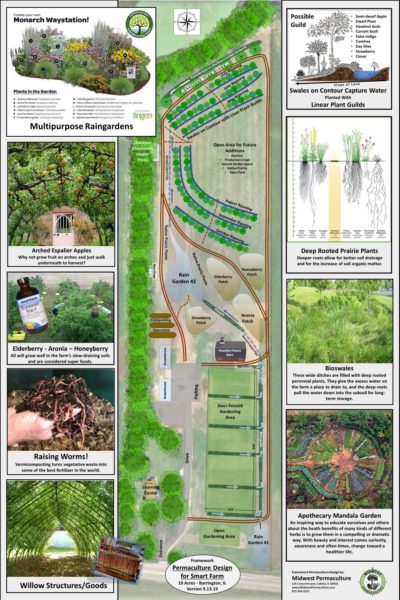Property Design Mini-Course (PDMC)
Just the Essentials for Immediate Design
- Online. Self-Guided. Start Now.
- The Complete PDMC Training Recordings (about 20 hours of video content) with all Related Resources
- Step-by-Step Guidance with Exercises for Self-Learning
- Start Now or Any Time, It’s Self Guided
- Includes Free Access to our Design Charrettes and Office Hours
In a hurry? Ready to start?
Bill pulled the most essential elements for the home, homestead or small farm owner, from the PDC course, who want to begin implementing a permaculture design as soon as possible. This condensed course covers what to do first, then next, and then next.
Sustainable, Practical, Permaculture.
This course will take you, step-by-step, and in the most logical sequence, through the permaculture property-design process. The training explores a multitude of ingenious strategies of how to harvest rainwater, grow nutrient-packed foods, increase efficiency and yields, and work with nature to minimize work and enhance ecological abundance.
Led by Bill Wilson (head teacher/designer of Midwest Permaculture for almost 2 decades) and Megan Christian (experienced MWP designer and teacher), this course will give you the confidence to start implementing permaculture design in your outdoor spaces at a residential, homestead, or small farm scale.

What is Covered in These 6 Info-Packed Recorded Sessions?
Session 1-4
The Residential Design
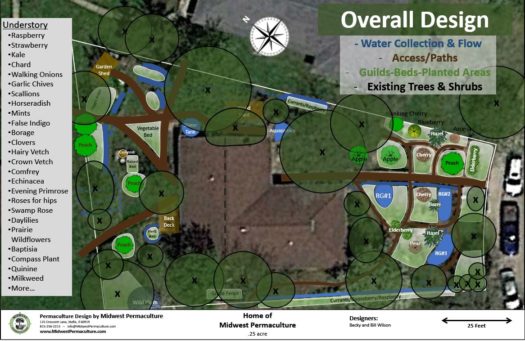
Focus is on Permaculture Zones 1 & 2 (home and yard)
- The principles of permaculture & the design process – Step-by-step
- The full SITE DATA AND DIGITAL DESIGN TUTORIAL (sold separately as well for $20) which will show you how to gather and interpret site data from the internet.
- Learn to use Google Slides or PowerPoint to create your digital permaculture design basemap
- Managing rainwater on a residential scale. What do you really need and where to put it. (rain gardens, moats, mini-ponds, hügelkulturs, porous pavers, cisterns, etc.)
- Designing with the sun in mind
- Identifying key locations, micro-climates and access paths
- Plant selection, plant guilds, and integrated planting strategies
- Building plant and soil health
- Basic hardscaping (fencing, vertical space, raised beds, cold frames, pergolas, small greenhouses, aesthetics, etc.)
- Creating your framework residential design
- Understanding contour lines and water flow
Focus is on Permaculture Zone 3 – production areas
- Assessing the practical use of swales and keylining
- Earthworks options/methods
- Orchards and food forests
- Small livestock raising for multiple yields (Tree-Range Chicken?)
- Possible income streams
- Polyculture vs. specialty crops
- Larger-scale Greenhouses
- Double-deer fencing
- Small ponds
- A quick look at energy and infrastructure design
- Creating your framework homestead permaculture design
Note: Combining graphic design work with photo images as seen here is easy for us to do using PowerPoint or Google Slides. We’ll show you how.
Session 6
Small Farm Design (10+ Acres)

Focus is on Permaculture Zone 4 – Long-term, larger scale production systems
- Locating the Key-Point and the Key-Line and determining if they are truly helpful/needed
- Is there a case for incorporating swales, keylining, linear food-forests and specialty production on your farm?
- High intensity grazing operation of larger livestock
- Efficiency. Profitability. Long-term Development
- A deeper look at energy and infrastructure design
- Creating your framework small-farm permaculture design
Each week builds upon the last. The 5th and 6th sessions are not sold separately of 1-4.
When you complete the sessions, one-on-one consultations with Bill are available for a fee if you would like him to review and add his own input to your final design.
We Explore a Few Student's Real Design Projects Too
Enjoy the recorded webinars as Bill Wilson and Megan Christian walk everyone through the design process and conclude in the later sessions by brainstorming various ideas and suggesting what changes the student might make to their design. This is not design theory or exercises; these are real people, with real properties and tangible goals, who have laid out their best design work gleaned from this training and the accompanying resources.


Purchasing The Property Design Mini-Course (PDMC)
Should you decide to take the full PDC course in the future, we’ll take half of the price of this course and apply it to the full PDC. Just email Becky to receive this student discount.
Interested in Having Bill & Megan Review Your Design Work With You When Done?
Add On A Private Consultation at a Reduced Rate
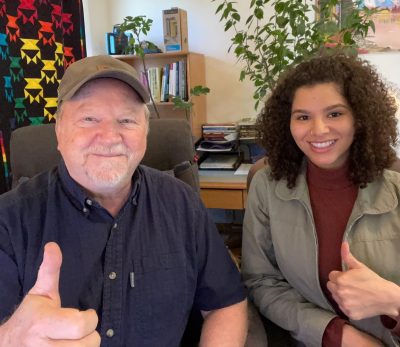
After you have gone through the training, gathered up your own site data, and come up with your best design ideas, we’d be happy to give you our thoughts and ideas for your project with a private consultation over Zoom.
-
Residential Property up to 1-acre (~1.5 hour Consultation):
List $695 – Student Price $495 $495 -
Homestead Property 1-10 acres (~1.75 hours Consultation):
List $845 – Student Price $645 $645 -
Small Farm over 10-acres (~2 hours Consultation):
List $995 – Student Price $795 $795
How to Access the Course After Ordering?
You will always be able to access any course you have purchased from us from the upper right-hand corner of any of our webpages under ‘Login’ or ‘My Account’. Here are the 3 Simple Steps to Finding Your Course if you need a bit of assistance.
50% Off for Midwest Permaculture PDC Graduates
If you are one of our PDC Course graduates, you will receive a 50% discount for this course.
The Property Design Mini-Course is a wonderful refresher if it’s been a while since your PDC. This course will take your design skills to the next level since we spend more time covering digital design than we do during the PDC.
To register as a past graduate, send an email to becky@midwestpermaculture with your name and the location of your course, and Becky will verify and register you directly.
You don't need to own property to take this course!
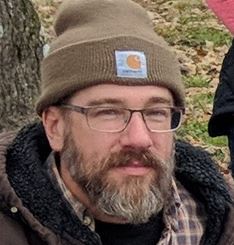
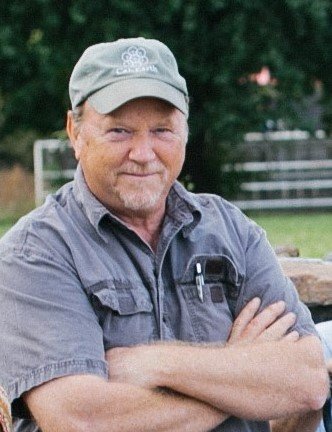
Why This New Design Training?
A word from Bill…
I’m glad you are considering this training. If you are in a hurry to gain the essential understanding to design your own property, this mini-course might be perfect for you.
Having walked over 2000 students and clients through the foundational permaculture design process, we know what essential information people really need to see the potential (and challenges) of any given piece of property. This training sheds light on this information in a condensed, easy-to-digest way.
I know you would gain a world of understanding and inspiration from the full Permaculture Design Certificate (PDC) course, but I also know that the time and financial commitment for a 72-hour training can be a hurdle for many.
By offering this course in a recorded format, you get to learn from home, eliminate scheduling conflicts, design your own property (if you have that), and receive a phenomenal permaculture training. This is a true permaculture model in efficiency.
Our goal at Midwest Permaculture is to get permaculture thinking/living/designing out into the world. I trust that this training will help.
Here’s to creating beautiful and functional properties in the world…Bill
Frequently asked questions:
There is No Certification with this training. It is a self-study program in which we guide you through about 25% of the Permaculture Design Certificate (PDC) course that contains the essentials of property design.
If you are not completely sure which level you’ll need, feel free to just sign-up for the 4 session residential course initially. If you later decide that the homestead and even the small-farm sessions would be helpful to you, you can sign up for them after. There are no extra charges if you register this way. We want this to work for you.
We do not take students for just weeks 5 or 6. Each week builds upon the previous.
Individual follow-up consultations with Bill are available after the training if desired, for an added fee. You can also just hire Bill to consult with you outside of this training at $300/hour if you would like him to review your own best plans or offer key pointers on your project.
- A Conceptual Design includes the broad stroke of ideas and possibilities for that property.
- A Framework Design identifies the most likely placement of earthworks (swales, raingardens, berms, ponds, etc.), other rainwater harvesting systems, larger planting systems and the placement of other key elements such as the home, paths and roads..
- A Full Design typically includes greater detail of all areas including specific plant cultivars, integrated elements, microclimates, recommended nurseries, time tables and estimated budgets for all.
A full permaculture design is far too customized and detailed for someone to create with this basic training. However, this course is loaded with insight and ideas while helping you get the foundational pieces right and over time you can develop your own Full Permaculture Design if that is desired. You can also hire us at anytime to co-create a full design with you.
Great. No problem. Students can use any software they are comfortable with, but our instruction is in Google Slides and PowerPoint. Learning the design process is what is really important-any graphic representation will work.
Probably the better question is what CAN it be like? Online learning varies widely but from our recent experience we have been able to make our courses feel like we are all in a room together while keeping the learning experience at a high level.
If you have never done online learning before do not let the technology stop you. Our tech team will help all who need assistance. Email Megan with any questions () or call our course voicemail line and leave a message at (815) 246-2894. We check messages twice a day.
Main Focus is on the Temperate Climate
Since this training is tightly condensed we don’t spend time exploring many of the design variations called for in desert or tropical environments. The design basics are the same for any climate but most of the techniques and details in this training will be particularly relevant to temperate climates where there are freezing temperatures in the winter.
If you live in a different climate, this mini-course will still walk you through the steps to designing any property, show you how to pull up online data for a site and interpret it, and teach you how to lay out a permaculture design basemap, but we will only be touching lightly on specific desert/tropical applications.

